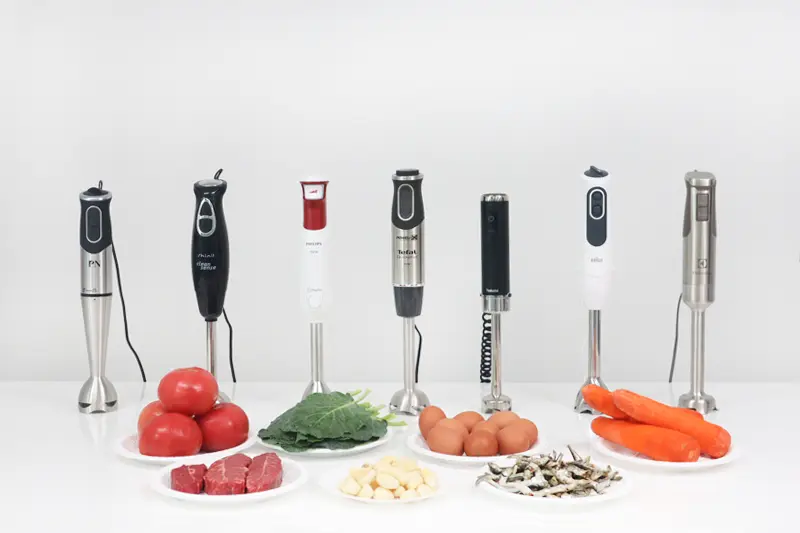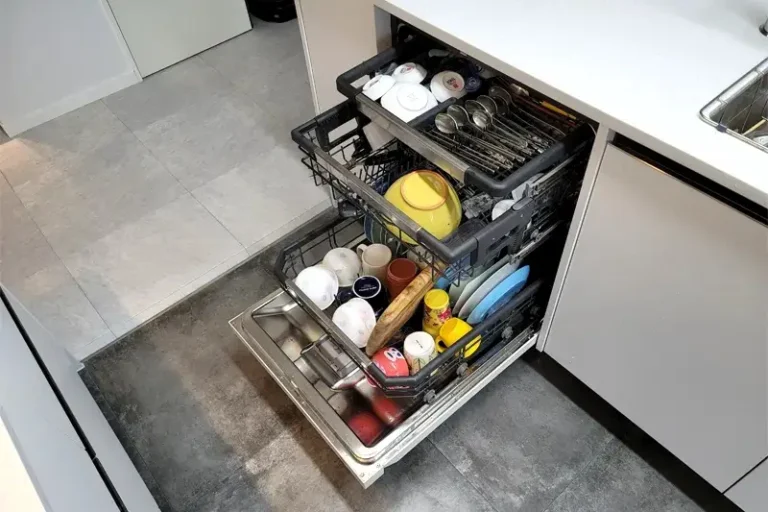The Best hand blender Buying Guide

How to Choose the Ultimate Multi-Purpose Hand Blender
Looking to make your cooking experience easier? If you’re passionate about cooking, you might be considering a hand blender (also known as an immersion blender) for easily making juices, chopping ingredients, mixing dough, and preparing sauces.
While hand blenders may not be as powerful as high-speed blenders, they offer excellent value with their affordable price point, convenience, and versatility. Let’s explore the key factors to consider when choosing a hand blender.
Chapter 1.
Use of hand blender
Hand Blender: Purpose and Pros & Cons
1. Operating Principle & Usage
A stick-type blender with exposed blades for various cooking tasks

A hand blender (also known as an immersion blender) is a versatile kitchen tool used to blend fruits and vegetables into juices, or make porridge, sauces, dough, meringue, and mayonnaise.
Unlike traditional blenders that require a sealed container, hand blenders operate with exposed blades attached to a stick-shaped handle, allowing you to blend directly in pots, measuring cups, or any open container.
2. Advantages of Hand Blender
Easy to use and versatile for various cooking tasks
Highly versatile for blending, chopping, and mixing dough

The first major advantage of a hand blender is its versatility.
While regular blenders focus mainly on ingredient processing, hand blenders can handle everything from making juices to chopping garlic and meat, kneading flour dough, and preparing various sauces, mayonnaise, and meringue.

The second advantage is the flexibility in container usage.
Unlike regular blenders that require specific containers, hand blenders can be used with any container that accommodates the stick – including bowls, plastic cups, and other vessels beyond the ones provided with the product. This versatility and convenience make hand blenders particularly satisfying for cooking enthusiasts who use them frequently.
Easy cleaning, storage, and affordable price

The third advantage is easy cleaning and storage.
The exposed blade design makes cleaning straightforward, and since it can be used with lidless containers, cleaning the vessels is also simple.
Additionally, hand blenders are much more compact than regular blenders, making them easy to store anywhere. Lastly, they offer excellent value for money. While high-performance regular blenders can cost $200-300, you can find quality hand blenders for around $50.
3. Disadvantages of Hand Blender
Not exceptionally powerful for blending

While soft fruits like bananas and strawberries blend easily, harder ingredients like carrots, frozen fruits, or ice cannot be processed as finely.

Ingredients like beans or dried anchovies, which high-speed blenders can process into fine particles, will result in coarser textures when using a hand blender.
Can be uncomfortable to hold while operating

Unlike regular blenders that operate with just a button press, hand blenders require you to hold the stick while pressing the button, which can be uncomfortable for those with weaker hand strength during extended use.
Also, since you’re manually controlling the device instead of it operating in a fixed position like regular blenders, the results can vary depending on user technique, potentially leading to uneven mixing or inconsistent results.
User satisfaction vs. dissatisfaction reviews

While some users find hand blenders highly versatile and satisfying, others may end up rarely using them due to disappointing performance or user experience. Though not an expensive appliance, it’s worth carefully considering whether you really need one before purchasing.
Chapter 2.
Blending Performance
What makes a good hand blender?
1. Power consumption
Recommend 600W or higher for better performance
Current hand blenders on the market range from 200W to 1000W. Since motor output increases with power consumption in hand blenders, higher wattage generally means better blending performance.
For simple tasks like making juice with soft fruits like strawberries and bananas or chopping garlic, models under 600W can work fine.
However, if you want finer blending results or need to process harder ingredients, we recommend choosing a model with 600W or higher.
No need for expensive models
While hand blenders vary in performance, the differences become minimal above a certain price point.
There’s no need to spend over $100, and even expensive models may feel less powerful compared to high-speed blenders. Since hand blenders require manual operation, user technique is particularly important.
Results can vary between users even with the same ingredients and quantities, so finding a model that matches your usage style is more important than price.
2. Speed control of Hand Blender
More speed settings are better, but 2-3 levels are sufficient

Products vary in speed control options, ranging from single-speed models to those with over 20 settings. While more detailed speed control allows for finer adjustments based on ingredients and purpose, most users typically only use 2-3 speed settings in practice.

Many models feature normal and turbo buttons with a dial for fine adjustment. However, products with over 10 speed settings can be hard to distinguish between levels, and it’s often awkward to adjust the dial while pressing buttons.
Users often end up fixing the dial and just using the buttons. Therefore, models with at least 2 speed settings or a turbo button are sufficient.
3. Blades & Accessories
Recommend models including whisk and chopper attachments
One of the main advantages of hand blenders is their versatility in cooking. For maximum utility, look for models that include a whisk and chopper along with the main unit and beaker, as these allow for making sauces, meringues, soups, and chopping ingredients.

Whisk for meringues and mixing

The whisk attachment replaces the blade on the stick. It’s primarily used for whipping cream, making meringues, beating eggs, and mixing batters.
Chopper for mincing and dough

The chopper is a container with dedicated blades that connects to the stick. It’s useful for chopping garlic and meat, grinding dry ingredients, and kneading flour dough. The lidded design prevents ingredients from splattering during use.
4. Operating time of Hand Blender
1 minute is too short – recommend 2-3 minutes of continuous operation

Hand blenders typically have continuous operation times of 1-3 minutes. Operating beyond the recommended time can cause burning smells or damage the unit.
Products with recommended operating times around 1 minute can feel too short when not timing usage, making it difficult to follow guidelines. Therefore, models with recommended operating times of 2 minutes or more are better for stable use.
Chapter 3.
User Convenience of Hand Blender
What makes a hand blender comfortable to use?
1. Weight & Size
1. Weight & Size
Recommend handle circumference under 6.7inches and weight under 30oz
Since hand blenders are operated with one hand, weight and grip comfort are particularly important considerations. If the unit is too heavy or large, it can be uncomfortable to use single-handedly.
Overly thick handles can be uncomfortable

A hand blender needs to provide a secure grip for comfortable use. Therefore, handles with too large a circumference can be uncomfortable.
While exact specifications for comfort vary by hand size, our testing with over 10 users across 7+ products showed that adult males found handles over 6.7inches in circumference less comfortable to grip.
Adult females with relatively smaller hands reported that handles under 5.9inches in circumference were more comfortable to use.
Heavy products are difficult to use

Beyond handle size, product weight significantly impacts usability.
Products weighing over 30oz caused discomfort after just 1-2 minutes of use. This was particularly noticeable when making meringues or other recipes requiring hand movement, as users needed to exert more force.
While those with greater strength may not need to consider weight as much, products under 30oz are generally comfortable for most users.
2. Cleaning & Maintenance
Recommend models with simple, detachable blades and caps without deep grooves

While the motor unit of hand blenders cannot be washed with water, the blades can be. Therefore, detachable designs where the blade separates from the main unit are easier to clean than all-in-one models.
Though most products are detachable, it’s worth double-checking before purchase whether your chosen model is detachable or all-in-one.

Single-layer straight or cross-shaped blades are easiest to clean. Double-layer blades can be challenging to clean if ingredients get stuck between the blades, and there’s a risk of cuts during cleaning.

3. Noise Level
Most operate above 60dB – difficult to find quiet models
Hand blenders tend to be quite noisy due to their compact size, which makes motor noise difficult to insulate.
Noise increases with rotation speed – our tests showed minimum speeds producing 50-60dB and maximum speeds exceeding 60-70dB. While noise perception varies by individual and most hand blenders are noisy, the short 1-2 minute operating time means noise level shouldn’t be a major consideration when choosing a model.
4. Cord Length
Choose based on usage environment – 1.2m+ sufficient for typical use

Most hand blenders are corded, though some cordless models have recently entered the market for added convenience. For corded models, longer cords provide more flexibility regarding outlet placement. While some products offer cords over 2m long, 1.2m is typically sufficient for standard kitchen use.






